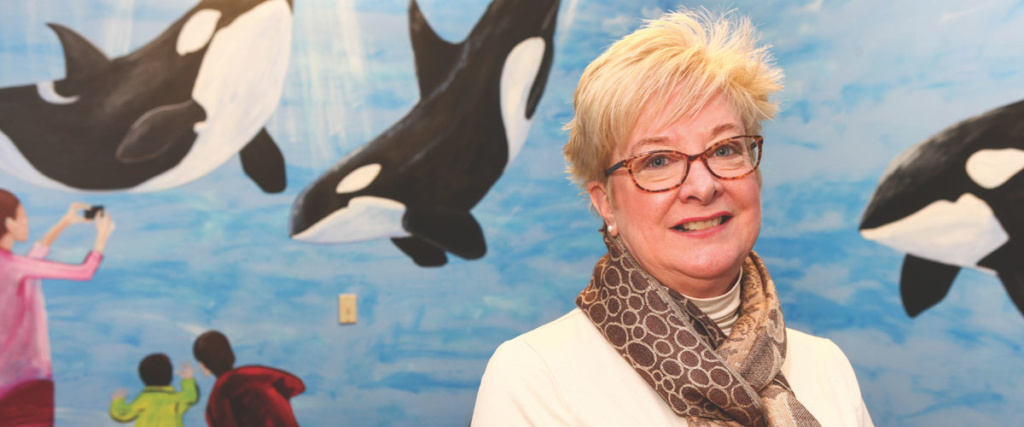When it comes to addressing cases of child abuse, there is no one-size-fits-all approach. For Linda Cleary, executive director of the McMahon/Ryan Child Advocacy Center in Syracuse, there is only one constant: People are very uncomfortable talking about it.
Each April, which is National Child Abuse Prevention Month, the center tries to change that. Its annual Go Blue 4 Kids awareness campaign is an effort to unite the greater community. Local landmark buildings are illuminated in blue, and blue pinwheels are planted around Central New York to catch attention and spark conversation.
It’s important to get people talking about child abuse. The McMahon/Ryan Child Advocacy Center fields nearly 700 calls a year related to severe physical and sexual abuse of children. It also provides different methods of healing for abuse victims and their families.
Access to law enforcement, legal experts, medical services, mental health therapy and education is provided all under one roof—at no cost. The center’s staff of 50 includes representatives from law enforcement agencies, the Onondaga County Department of Social Services, the Onondaga County District Attorney’s Office, medical personnel from SUNY Upstate Medical Center, and Vera House.
Clients can call the center directly, but most of the time, they are directed to McMahon/Ryan from a law enforcement agency, Onondaga County Child Protective Services office, or a hotline call.
Cleary says the volume of calls is evidence of progress, in terms of recognizing and reporting abuse. And, while providing services to clients will always be the center’s primary mission, community education is a growing focus.
“We have four full-time outreach and education specialists. Anyone that wants us to come and do a presentation, we go,” Cleary says. “We have a curriculum, ‘Darkness to Light: Stewards of Children,’ which is a video-based program for adults who want to learn what child abuse is and how to recognize it; what to do if they see it; and how to respond to it.”
“We also do a large amount of school-based training,” says Cleary, a parent and grandparent who lives in Manlius. There is a child abuse prevention program for pre-K through second grade, and a new program for third- through fifth-grade students.
“We’d rather have 10,000 calls and have all of them be false than to have missed something because you didn’t make that phone call.” — Linda Cleary
“We go into the classroom for 25 minutes each week for four weeks. We send information home every week, so parents know what we’ve talked about, and activities to keep the conversation going,” Cleary says.
The center also offers anti-bullying and internet safety programs for middle and high school students—in partnership with the Onondaga County District Attorney’s Office. “Last year, we were in 50 schools and saw over 16,000 children,” Cleary says. “Those numbers will probably continue to grow.”
Any business or organization can request a program that fits its needs. “We will go in, literally just to say, ‘Here is what McMahon/Ryan is, we are a resource for you, we are a phone call away if you’ve got a question — if something doesn’t look right and you’re not sure what to do.’”
For school staff, McMahon/Ryan offers mandated-reporter training. “We’d like as many school personnel as possible to take our ‘Darkness to Light’ training. We also want to educate the soccer coaches, the city Parks and Rec personnel, and other people who are interacting with children,” Cleary says.
Several local municipalities seek annual training for their summer program staff.
“A critical thing is that if a child says something, you have to know the correct response,” Cleary explains. “That response can’t be: ‘Oh, no. That didn’t happen.’ That is the worst thing they can say.”
Cleary encourages all adults to call the center if they have questions as to whether a situation should be reported. “We’d rather have 10,000 calls and have all of them be false than to have missed something because you didn’t make that phone call.”
Last year, the center saw 65 victims of human trafficking — children who had been forced or coerced into providing labor, service or commercial sexual favors.
“We are seeing an increase in these numbers because it’s new,” Cleary says. “Trafficking isn’t new, but people are starting to recognize and report it. The Safe Harbor Law protects young victims and makes it possible for them to access services.”
No matter the reason for contacting the center, client needs vary greatly.
“Certainly the child is traumatized, and the non-offending caregiver has a level of being traumatized,” Clearly explains. “They don’t know what they are supposed to do. They just know that something has happened, and they need help. After that first phone call, they are scheduled for a forensic interview. All of our law enforcement and child protective services staff have been trained in forensic interview best practices.”
Clients are greeted by one of the center’s victim advocates during their initial visits. The advocates assist those families throughout the process.
“This process works slowly,” Cleary acknowledges. “Sometimes, families panic if they haven’t heard from their assistant district attorney. That’s not uncommon. So, the advocate is really that one person who can help them stay focused and make sure their needs are being met.”
In cases where there is not enough evidence to bring a charge against an accused abuser, victims’ families can become disheartened. In other cases, when an abuser is brought to trial, families may wrestle with the decision of whether or not the child should testify in court.
In 90 percent of reported abuse cases, the perpetrator is someone the child knows and trusts. “Fairly often, it’s another family member,” Cleary says. “The child is often afraid to say anything… There are so many emotions and so much that everybody goes through.”
Some families stay in contact with an advocate for just a few weeks, while others maintain long-term connections. “If someone comes in today and says, ‘We don’t need an advocate,’ we don’t say ‘Okay, you’re done.’ The advocates call each week for four weeks to say, ‘Hey, is everything okay?’ Cleary says. “Six months down the line, they may have some issues, or a specific need, and we kick right back into gear again. Like everything else in this field, it depends on the needs of the families.”
Regardless of how much support clients use, Cleary says by just getting in touch with the center, they are started on a path to healing.
“It’s the children who live their entire lives without ever disclosing, without ever telling anybody, who get to a point in their lives where things just sort of fall apart,” she says. “As painful as it is, we would much rather have a child say something, because now we can put them on that path to healing.”
Cleary points out that parents rarely think about the potential for abuse in everyday situations. “When you drop your child off for soccer practice or baseball practice, are you asking the right questions? We routinely don’t because it is uncomfortable. It’s okay to ask those questions.”
Cleary likens the issue of child abuse to the response to domestic violence years ago. She and her colleagues will continue to work toward changing that—and not just every April.
“If we can just continue, from an outreach and education standpoint, to keep the topic in the forefront, and to get people talking about child abuse and what they can do to prevent it, then ultimately, years down the road, we should see the numbers of cases go down,” Cleary says. “Ultimately, our hope is that enough adults are going to pay attention so that it can be reduced.”
“People need to understand what child abuse is, and that it takes place,” Cleary says. “There is a perception that it takes place only in certain neighborhoods. It’s happening in everybody’s neighborhood. It doesn’t matter what your socioeconomic standing is, or what your ethnicity is, where you live or how old you are.”





